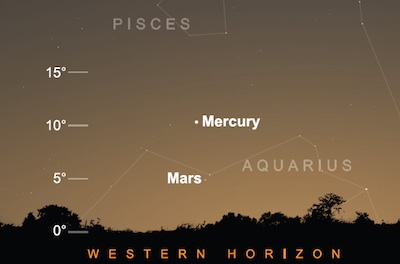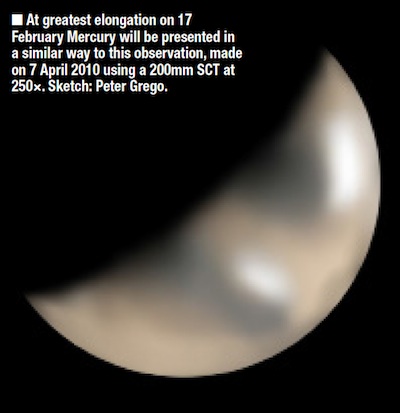



|

|

Mercury appears at dusk throughout February
BY MARK ARMSTRONG
ASTRONOMY NOW
Posted: 11 February 2013

One of February's highlights for observers in tropical and northern latitudes is the year's best evening apparition of fleet-footed Mercury, the innermost planet reaching greatest eastern elongation (18 degrees) from the Sun on 16 February.

This is the view to the western horizon on the early evening of 17 February when the innermost planet is at greatest eastern elongation. It's the last hurrah for Mars at this apparition. Credit: Astronomy Now graphic by Greg Smye-Rumsby
|
Strange as it may seem at first, many astronomers have never seen Mercury, but it's not really that surprising as it never strays more than 28 degrees from our star, so it's only ever visible close to the horizon at dawn or dusk, often subject to poor seeing. Furthermore, it's seldom more than 10 degrees above the horizon from the UK and often hidden behind the houses for urban and suburban dwellers. Mercury is so swift a mover that its comes and goes very quickly from the Northern Hemisphere, with typically a two to three week window of opportunity at best. Generally, there's only three chances per year to observe Mercury in the morning sky and the evening sky but not all elongations, either morning or evenings are created equal with elongations from the Sun ranging from 18 to 28 degrees. The angle of the ecliptic to the local horizon is crucial in determining how well placed Mercury is, too, with more favourable steeper angles much more common down-under and the Southern Hemisphere also benefits from its highly inclined orbit (seven degrees to the plane of the ecliptic) which places it above or below the ecliptic.
During February, the planet starts to makes its presence felt from around now but only if you have access to a clear west-south-west horizon. On 7 February, the planet is six degrees above the horizon at the end of civil twilight (Sun six degrees below the horizon), shining at magnitude -1.0 and showing an 83.5 illuminated phase across its 5.7 arcsecond disc. Mars is within a degree north and this is one of the last chances to see the red planet in February. Mars is outshone by over two magnitudes has is almost as tiny as it can get in apparent diameter, a fraction over four arcseconds.

|
As the month progresses, Mercury gradually pulls out from the Sun but fades as it does so; however, its altitude increases for the same degree or extend of twilight. Its phase decreases and apparent diameter increases, too. On 16 February, at greatest elongation Mercury is 10.3 degrees up at 5:50 p.m., shining at a still relatively bright magnitude -0.48 and if you can get a telescope on it, its phase is close to half at 51 percent and its disc swelled to 7.1 arcseconds in apparent diameter. The changing phases are easy to see in a small telescope and low contrast, indistinct surface markings can be seen in good conditions with apertures above 130-mm. Colour filters should certainly be tried with orange, red and deep red best; one caveat is that the later cuts out most light and is best employed on larger scopes in the 250-mm and upwards class, where sheer light grasp offsets the filter's attenuation. If you can observe with a larger aperture then have a go at sketching Mercury or some high resolution imaging, especially if your seeing conditions appear favourable. Why not try too some simple snap shots with your digital SLR camera - Mercury and Mars are within 0.3 degrees of each other on 8 February so this is a good opportunity. Astronomy Now will be delighted to receive your sketches and images!
If you have a GOTO telescope, then with great care Mercury can be observed in daylight when it is obviously much higher in the sky. However, morning apparitions are best in this respect, when the planet can be easily followed after sunrise with the seeing often more favourable as the thermal effect are minimised early in the morning. After 25 February, Mercury is lost to the solar glare as it heads in towards the Sun and inferior conjunction early next month.
|

|

|

|
|



